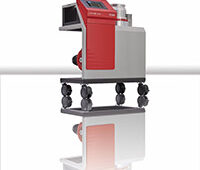
The laboratory scientist work with microwave plasma atomic emission spectrometer (MPAES) for elemental property analysis of material sample in all areas of industry.
Atomic spectroscopy is the determination of elemental composition by its electromagnetic or mass spectrum. The study of the electromagnetic spectrum of elements is called Optical Atomic Spectroscopy. Electrons exist in energy levels within an atom. These levels have well defined energies and electrons moving between them must absorb or emit energy equal to the difference between them. In optical spectroscopy, the energy absorbed to move an electron to a more energetic level and/or the energy emitted as the electron moves to a less energetic energy level is in the form of a photon. The wavelength of the emitted radiant energy is directly related to the electronic transition which has occurred. Since every element has a unique electronic structure, the wavelength of light emitted is a unique property of each individual element. As the orbital configuration of a large atom may be complex, there are many electronic transitions which can occur, each transition resulting in the emission of a characteristic wavelength of light.
Performing atomic absorption spectroscopy requires a primary light source, an atom source, a monochromator to isolate the specific wavelength of light to be measured, a detector to measure the light accurately, electronics to process the data signal and a data display or reporting system to show the results. The light source normally used is a hollow cathode lamp (HCL) or an electrodeless discharge lamp (EDL). In general, a different lamp is used for each element to be determined, although in some cases, a few elements may be combined in a multi-element lamp. In the past, photomultiplier tubes have been used as the detector. However, in most modern instruments, solid-state detectors are now used. Flow Injection Mercury Systems (FIMS) are specialized, easy-to-operate atomic absorption spectrometers for the determination of mercury. These instruments use a high-performance single-beam optical system with a low-pressure mercury lamp and solar-blind detector for maximum performance.
The environmental, food, pharmaceutical, petrochemical, chemical/industrial and geochemical/mining industries all use atomic spectroscopy for basic elemental determinations on a diverse array of samples. There are three widely accepted analytical methods – atomic absorption, atomic emission and mass spectrometry.
The most common techniques today are flame atomic absorption spectroscopy, graphite furnace atomic absorption spectroscopy, inductively coupled plasma optical emission spectroscopy (icp-oes) and inductively coupled plasma mass spectrometry (icp-ms).





Tell Us What You Think!